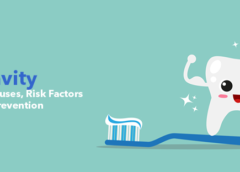Overview
Cavities are permanently damaged areas that form into tiny gaps or holes in the hard surface of your teeth. Cavities, also known as caries or tooth decay, are caused by a combination of factors, including bacteria in your mouth, frequent snacking, sipping sugar beverages, and failing to clean your teeth.
Cavities and tooth decay are among the most common health problems in the world. They are particularly common in children, adolescents, and older adults. However, anyone with teeth can get cavities, including infants. Therefore, many children at a young age get their most natural looking dentures to maintain their oral health.
If cavities aren’t treated they get bigger and affect your teeth’s deeper layers. They can lead to serious toothache, infection, and loss of dentures. Daily dental appointments, and good brushing and flossing practices are your best cavity and tooth decay defense.
Symptoms
The symptoms of a cavity depend on the severity of the decay. They include:
- Tooth sensitivity
- Tooth pain
- A visible hole in your teeth
- Black or white staining on your teeth
Read More: How to Take Care of Teeth
Causes
Our mouths are full of bacteria. Some bacteria are helpful. But some can be harmful, including the ones that play a role in tooth decay. With food these bacteria combine to form a soft, sticky film called a plaque. The bacteria in plaque use the sugar and starch in what you eat and drink to make acids. The acids on your enamel start eating away at the minerals. Over time, the plaque can harden into tartar. Besides damaging your teeth, plaque and tartar can also irritate your gums and cause gum disease.
You get fluoride from toothpaste, water, and other sources. As well as your salvia, this fluoride helps the enamel repair itself by replacing the minerals. Your teeth go through the normal cycle of mineral loss and mineral recovery all the day. But if you don’t take care of your teeth and/or you eat and drink lots of sugary or starchy things, your enamel will keep losing minerals. This leads to tooth decay.
There may be a white spot where minerals have been lost.. This is an early sign of tooth decay. At this point, you may be able to halt or reverse the decay. If you take better care of your teeth and limit sugary or starchy foods and drinks, your enamel can still repair itself.
Risk Factors
Saliva helps prevent plaque from sticking to teeth, and helps wash away food contaminants and digest them. A low salivary flow or dry mouth makes the teeth more susceptible to decay. This is particularly common in patients with diseases that feature dryness of the mouth, Such as Sjogren’s syndrome and other diseases of the salivary glands. The following genetic factors affecting tooth decay include:
- Tooth size and shape:
Small teeth with multiple deep pits and grooves would be more vulnerable to
cavity formation than broad teeth with less and shallower grooves. The grooves
and pits provide areas for plaque to build up and are difficult to brush
thoroughly. - Thickness of enamel:
Enamel is the primary protection of the tooth against cavities, and the longer
it takes for a cavity to crack through to the inside of the tooth, the more
damage an individual has. - Tooth position and bite:
crooked, overlapped teeth provide more plaque area to accumulate and are more
difficult to clean. Many problems can occur if the bite is poorly aligned. Poor
bite alignment can cause a rapid wear down of the enamel on some teeth, leaving
soft dentin exposed. Orthodontics is a great measure for cavity prevention,
since straight teeth in a proper bite position tend to remain cleaner and
cavity-free throughout a person’s lifetime.
- Tooth eruption time and sequence: People who get their permanent teeth earlier in life are at
higher risk of developing cavities as oral hygiene habits may not yet be
established.
Complications
Cavities and decay of the tooth are so common you might not take them seriously. And you might think it doesn’t matter if the kids get cavities in their teeth. Cavities and tooth decay, however, can cause serious and lasting complications, even for children who do not yet have their permanent teeth.
Complications of cavities may include:
- Pain
- Tooth abscess
- Swelling or pus around a tooth
- Damage or broken teeth
- Chewing problems
- Positioning shifts of teeth after tooth loss
Prevention
The first step in preventing a dental cavity is to start and keep up with a comprehensive oral hygiene routine. While this can sound overwhelming, you’ll be happy to enjoy the healthy mouth and beautiful smile that comes with good oral hygiene once it’s become a habit. While there are many oral hygiene options these days, here’s a basic checklist of the core items you’ll need to incorporate into your daily routine to help prevent a dental cavity.
When you head to the drug store, take this handy list to help get you started on the path to better oral health and hygiene and the prevention of a dental cavity.
- Toothbrush: Everyone knows you need a toothbrush to keep
your teeth clean, but many donate give the variety of toothbrushes much thought.
Although hundreds of options are available, search carefully to find a
toothbrush which can touch all your teeth’s surfaces. Finding a brush that
includes a textured tongue cleaner is also a good idea, since bacteria that
cause oral malodor often live in your tongue. - Toothpaste: it is a vital part of the dental cavity protection oral hygiene routine.
- Mouthwash: Mouthwash is always the last step in an efficient everyday routine for oral hygiene. Not
only does the use of a therapeutic mouth rinse leave your mouth feeling clean
and your breath fresh, it kills the bacteria that can cause plaque and
gingivitis.

Leave a Reply
You must be logged in to post a comment.